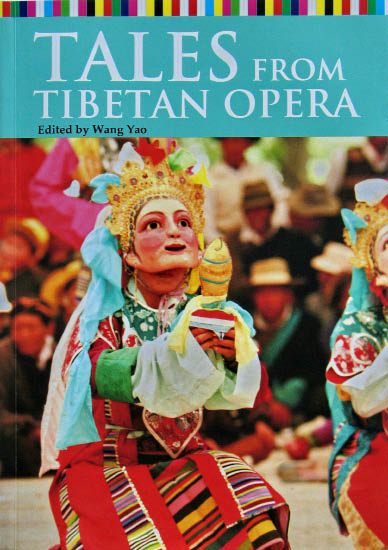Learning About Tibet from Opera
By staff reporter LIU YI
Tales from Tibetan Opera Edited by Wang Yao 195 pages RMB 56, paperback Published by New World Press in Beijing, April 2013

Where there is a Tibetan community, there is also Tibetan Opera. One of the oldest forms of drama among peoples of Central Asia, Tibetan Opera can be traced back to the 13th century. Thang-stong-rgyal-po (1385-1464), a lama of the White Sect of Tibetan Buddhism, is believed to be the founder of Tibetan Opera. He wrote many dramas that musically portray religious stories and biographies of great men.
From the 17th century Tibetan Opera developed into the performances seen today. The librettos, dances, melodies, masks and costumes of Tibetan Opera have gradually evolved through combining religious rites, folk dances, songs, ballad-singing and story-telling. Countless artists, playwrights and drama lovers of the nobility refined and enriched its form. Tibetan Opera is popularly performed in neighboring Sichuan, Yunnan, Gansu and Qinghai provinces as well as throughout Tibet Autonomous Region.
A true appreciation of the historical legacy of Tibetan Opera requires delving into opera classics. The eight Tibetan Opera dramas presented in this book are local favorites. The first, Princess Wencheng, is one of the most famous as well as a representative piece with a historical theme.
In 640, Princess Wencheng (625-680) of the powerful Tang Dynasty was sent to marry Song-tsen Gampo (?-650), king of Tubo, a strong regime in Tibet. The princess took medicines, grain and vegetable seeds, books on science and technology, exquisite handicrafts and a retinue of craftsmen to the desolate plateau.
The marriage promoted cultural and economic communications between the inland and Tibet, as well as the latter’s productivity. Generations of poets write verses in praise of Princess Wencheng, and historical records mention local people’s esteem and admiration of the princess. The Tibetan Opera Princess Wencheng is drawn from such historical data and folk legends, and enriched with artistic imagination.
The play comprises many scenarios well known among all Chinese opera lovers. To win Princess Wencheng’s hand, the king’s envoy Blon-ston-btsan had to perform feats such as threading a zigzag hole in a bead with silk filament, enabling 100 foals to find their mothers and identifying the princess among 300 beautiful ladies. His success in all proved his folk skills, intelligence and down-to-earth wisdom.
Tibetan Opera has a strong flavor of folk myths and retains the romanticism of creative folk writing. Prince Nor-bzang is a representative play based on a folk tale about Prince Nor-bzang, who falls in love with the goddess Yidvphrog-lha-mo, so enraging his concubines. The prince is falsely sent to fight in a distant place, leaving the goddess unprotected. To escape murder she flies back to her palace in heaven. After the prince returns he goes to the palace of heaven to bring the goddess back. They live happily thereafter.
Tibetan playwrights also wrote about the lives of ordinary people and their social customs. Maiden Snang-sa tells of the misfortunes of a peasant girl, based on true events well known to local people. The beautiful and kind Snang-sa was forced to wed the son of her lord. After marrying she worked hard all day long but her husband still flogged and humiliated her. Eventually she died of grief. The king of hell sent her back to the world and she became a nun. Later both the lord and his son, after attending Buddhist teachings, converted to Buddhism.
The opera evokes deep empathy for the working people, especially women. Audiences love the opera because they readily identify with Snang-sa. It is said that in old times whenever the play was performed, both performers and audience would dissolve into heartfelt sobs.
The opera also reflects a strong connection with Buddhism, attributable to its ties with the art of ballad singing. In the early days of Tibetan Opera, balladeers specialized in stories from Buddhist scriptures. Their verses gradually developed from narration by a single performer to that by a company of actors, each singing their own part. Tibetan operas hence contain arias drawn from Buddhist sutras.
In earlier times Tibetan Operas were usually performed during the Shoton Festival in the seventh and eighth months of the Tibetan calendar. Local lords sent their theatrical troupes to Norbu-gling-kha, Lhasa, to perform for the Dalai Lama and government officials. This was the “performance corvee” for actors.
After the official performance, troupes would go on a tour. Actors eked out their livelihood from scanty donations and by farming small plots of land rented from manorial lords. They were menaced by starvation, disease and suffered humiliation at the hands of officials and aristocrats. It was thanks to the consistent efforts of the few that remained faithful to the theatrical art that this precious artistic heritage survived.
After the peaceful liberation of Tibet in 1951, a state-owned Tibetan Opera troupe was formed. Privately owned and amateur theatrical troupes have also made substantial progress. Writers and artists have studied and researched the heritages of Tibetan Opera. Performance costumes, stage props, settings and makeup have been renewed through assimilating elements of other operas.
This book is the first attempt at a thorough explanation of the main performance elements of Tibetan Opera. It also gives readers a glimpse of the magnificent natural scenery, simple life, religious beliefs and unique customs of the Tibetan people.

